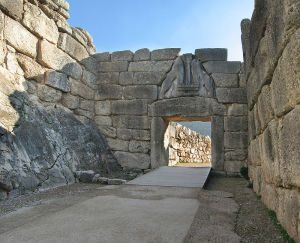
Mycenae — the ancient city of the legendary King Agamemnon, best known from Homer’s Iliad and Odyssey and its iconic Lion Gate and cyclopean defensive walls, has long fascinated scholars and site visitors alike with the epic proportions of its imposing citadel remains. Located about 56 miles southwest of Athens in Greece, it is a World Heritage site.
But there is another Mycenae — one known for centuries from ancient historical documents — which has nevertheless eluded the eyes of archaeologists, historians, and tourists. One might call it “Greater Mycenae”, the Lower Town. It is invisible because most of it still lies undetected, unexcavated, below the surface. In its heyday it was a second millenium BC version of urban sprawl that served as a vital element of the ancient city’s florescence.
Few know it better than Christofilis Maggidis, Associate Professor of Archaeology at Dickinson College in Pennsylvania. He has been leading excavations there since 2007. Geophysical surveys utilizing remote sensing technology in the area surrounding the citadel revealed substantial evidence of hidden walls, structures, gates, roads and other features of a possible urban center surrounding it on its south, west and north sides.
“This town may have extended over an area of ca. 30-50 hectares, with a normal population density of 200 people per hectare, consisting mainly of domestic units and commercial buildings, but also including larger palatial structures and annexes (workshops, offices, storerooms) located closer to the main access roads and highways,” writes Maggidis in a report published in the Volume 15 issue of Popular Archaeology . “The discovery of two gates, associated perhaps with an outer circuit wall, further reinforces the possibility of an organized town plan.”*
Ground proof excavations confirmed the geophysical findings. Uncovered thus far were Mycenean-period features that included a long retaining wall possibly connected to a gate, a wall possibly connected with an outer fortification wall of the Lower Town, two buildings, and an apsidal structure. Overlaying the Mycenean features were post-Mycenean findings that included Geometric Period structures such as a pottery/ivory workshop with a cistern, a multi-room house with a courtyard and containing three infant burials under the floor of a room, two circular structures, and a 9th century B.C. cist grave. The cist grave, which contained the skeletal remains of a young woman, consisted of funerary meal remains, an iron pin found on the right shoulder-blade, an iron ring found around a phalanx of the right hand, and five clay vases and a cup placed around the body.
_______________________________
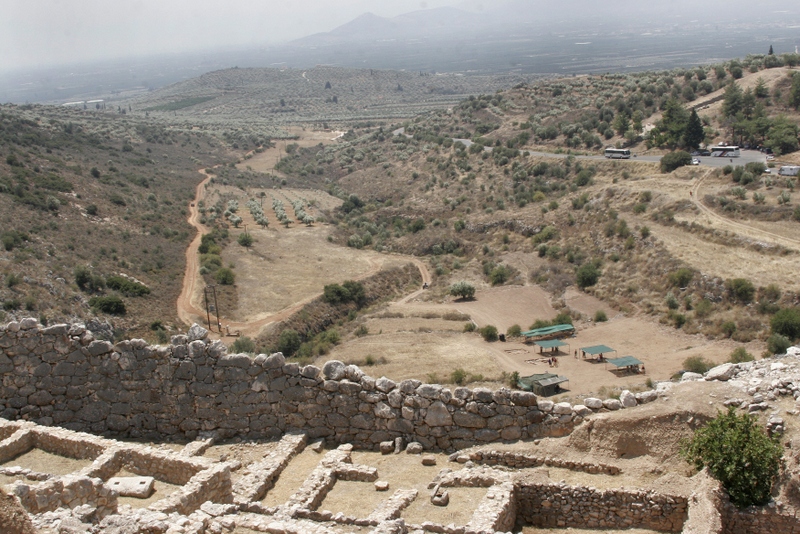 View of the Lower Town area and excavation site from the citadel area of Mycenae. Courtesy Dickinson Excavation Project and Archaeological Survey of Mycenae
View of the Lower Town area and excavation site from the citadel area of Mycenae. Courtesy Dickinson Excavation Project and Archaeological Survey of Mycenae
________________________________
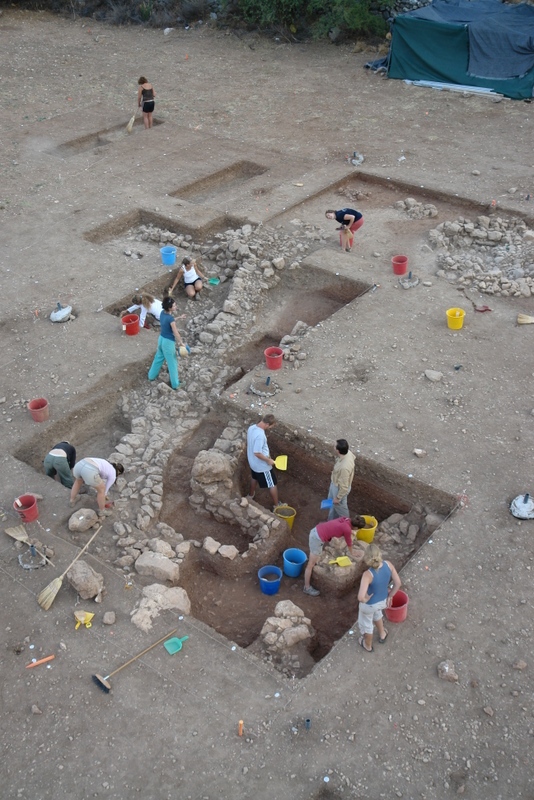 Excavators at work on the Lower Town site. Courtesy Dickinson Excavation Project and Archaeological Survey of Mycenae
Excavators at work on the Lower Town site. Courtesy Dickinson Excavation Project and Archaeological Survey of Mycenae
_________________________________
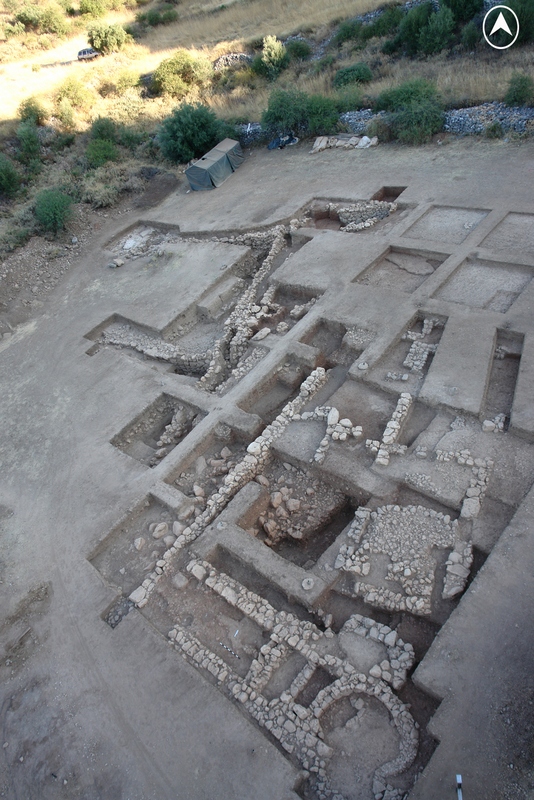 Overhead view of the excavation site. Courtesy Dickinson Excavation Project and Archaeological Survey of Mycenae
Overhead view of the excavation site. Courtesy Dickinson Excavation Project and Archaeological Survey of Mycenae
______________________________
Numerous artifacts were unearthed. Writes Maggidis: “A great number and wide variety of finds have been retrieved so far, including fragments of Mycenaean and Archaic figurines, flint and obsidian blades, flakes and cores, stone tools, fragments of stone vases, stone cloth weights, seal-stones, beads and pendants, rings, glass shards, metallic objects, coins, lead sheets, iron nails and hooks, lead clamps for pottery mending, ivory objects, clay loom weights and spools, fresco and plaster fragments, color pigments, carbonized wood, animal bones, shell, roof tiles and abundant pottery.”*
_____________________________________
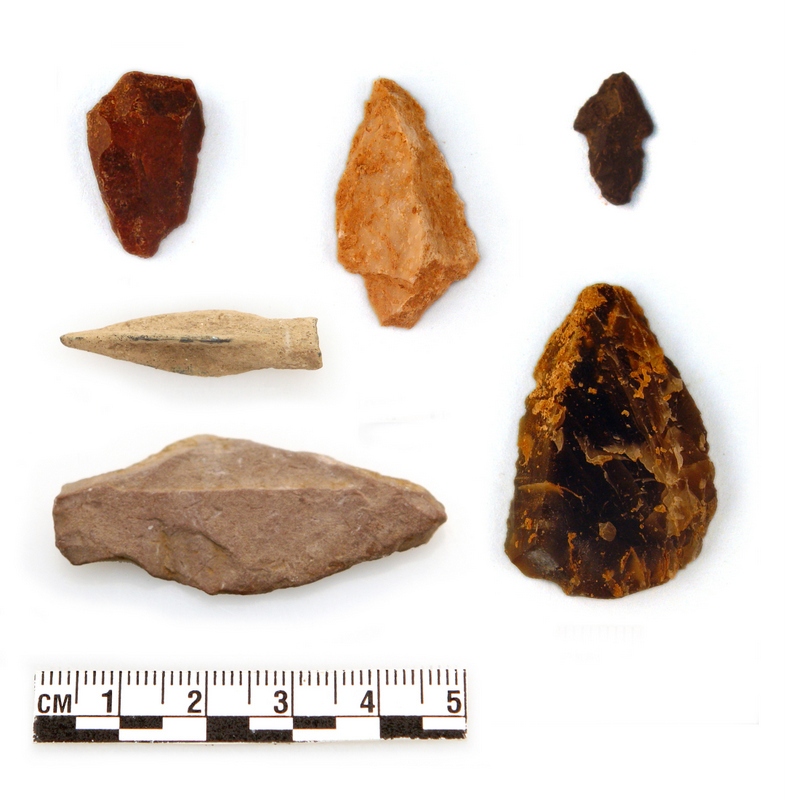 Arrowheads discovered during excavations. Courtesy Dickinson Excavation Project and Archaeological Survey of Mycenae
Arrowheads discovered during excavations. Courtesy Dickinson Excavation Project and Archaeological Survey of Mycenae
________________________________
But the greatest takeaway thus far has been the confirming evidence that Mycenae, more than its popular image as the fortified palatial abode of Agamemnon, was a large, complex urban center where a population made their living in trade, commercial production, agriculture, and all the other typical functions of an ancient culture, in space and time well beyond the politics and military campaigns of a prominent kingly reign.
“The geophysical survey and systematic excavation of the Lower Town at Mycenae revealed an extensive Mycenaean settlement outside the citadel,” reports Maggidis, “which was protected by an outer fortification wall with gates, as well as overlying structures and buildings dating to the Early Iron Age and the Archaic Period, thus establishing for the first time a continuous, well-stratified occupation of Mycenae in all the successive periods from the 13th century BC to the 6th century BC.”*
Maggidis and his archaeological team, which will include students and volunteers, will be returning to resume excavations during the summer of 2014.
The latest detailed report of the investigations of the Lower Town at Mycenae are published in the Vol. 15 issue of Popular Archaeology Magazine, available in early June, 2014.
* Maggidis, Christofilis, Unearthing the City of Agamemnon: The Survey and Excavation of the Lower Town of Mycenae, Popular Archaeology, Vol. 15.
Cover Photo, Top Left: The Lion Gate at Mycenae. Andreas Trepte, Wikimedia Commons
______________________________________________
Read about the most fascinating discoveries with a premium subscription to Popular Archaeology Magazine. Find out what Popular Archaeology Magazine is all about. AND MORE:
On the go? Purchase the mobile version of the current issue of Popular Archaeology Magazine here for only $2.99.
Popular Archaeology’s annual Discovery Edition eBook is a selection of the best stories published in Popular Archaeology Magazine in past issues, with an emphasis on some of the most significant, groundbreaking, or fascinating discoveries in the fields of archaeology and paleoanthropology and related fields. At least some of the articles have been updated or revised specifically for the Discovery edition. We can confidently say that there is no other single issue of an archaeology-related magazine, paper print or online, that contains as much major feature article content as this one. The latest issue, volume 2, has just been released. Go to the Discovery edition page for more information.





